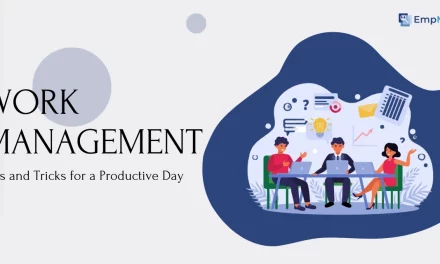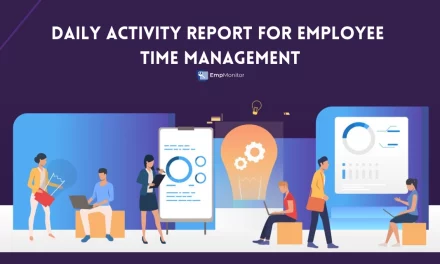Procrastination is a problem that many employees come across. Many team members desire to overcome procrastination and stay motivated at work. But simply forcing yourself to be motivated won’t solve the issue. The actual cause of procrastination is not a lack of motivation but rather an unclear understanding of what has to be done and why.
Sometimes, it is difficult to see clearly what we should be doing and why it is vital. To tackle this, you need a reliable method and a clear plan to keep track of your tasks and goals. Sans this clarity, you might find yourself stuck in unproductive cycles.
In this blog, we’ll explain how not understanding the significance of your work leads to procrastination and what steps you can take to overcome it.
Before learning ways to overcome procrastination, it is vital to understand what it is. Let us get to know about it first.
In a hurry? Listen to the blog instead!
What Is Procrastination?
Procrastination is the act of postponing essential tasks by engaging in less significant activities or becoming distracted by things like social media or television. It involves delaying decisions or actions despite understanding the benefits of starting sooner.
For example, someone might do it by waiting until the final hour to begin a task despite acknowledging the importance of starting earlier. This tendency to delay vital tasks often results in unnecessary stress and can hinder productivity.
Recognizing and addressing procrastination habits is crucial for effectively managing time and achieving long-term goals.
Why Do Employees Procrastinate At Work?
Procrastination occurs when employees prioritize immediate satisfaction over future benefits despite knowing they should concentrate on completing tasks promptly. This tendency stems from the preference for instant gratification over working toward long-term goals.
It’s essential to integrate employee engagement solutions and elements of immediate reward into long-term projects to address this issue. As a team leader, one way to overcome procrastination is by regularly providing appreciation and constructive feedback as part of the daily work routine.
This approach can motivate individuals to stay focused and committed to achieving overarching objectives.
Reasons Behind Procrastination:
People procrastinate at work for various reasons, including laziness, lack of self-control, fear of failure, and the habit of putting things off. Other factors such as perfectionism, feeling like the work isn’t urgent, confusion about requirements, negative self-talk, fear of complex projects, and multitasking also contribute to procrastination.
However, these reasons all share a common root cause: lack of clarity. If you find yourself putting off tasks, it’s because you don’t know why they’re vital. It’s not a case of being lazy; it’s a problem that can be fixed by understanding the importance of the tasks you need to do.
And how can you get the required clarity to overcome procrastination? Let us learn about it.
Acquiring Clarity
A common cause of procrastination is an inability to understand how tasks relate to organizational objectives. Understanding this link boosts motivation, simplifies decision-making, and helps prioritize tasks effectively and overcome procrastination. Clear, specific goals are vital to prevent procrastination; connecting work to company objectives is the key.
There are two approaches to address this issue of clarity. They are:
Establish team or department goals:
If it’s challenging to see how your work fits in the company’s overall objectives, consider setting goals specific to your team or department. It helps to understand the connection between your tasks and your team’s goals, clarifying your impact.
Connect your personal work to company goals:
Even if team or company goals aren’t available, find ways to link your tasks directly to broader company objectives. For instance, understanding how your work contributes to a project aligned with company goals can provide clarity. Utilizing project management software like EmpMonitor can help visualize your work’s value and its impact on company progress.
Now that we have learned all about procrastination- let us understand the top 5 ways to stop procrastinating.
Top 5 Tips To Overcome Procrastination:
To overcome procrastination at work, set shorter-term goals for your team or department or link your tasks to broader company objectives. Here are five tips you can utilize.
Divide Large Projects Into Smaller, More Manageable Tasks:
At times, tackling a large project can seem daunting, leading to procrastination. The complexity of the task makes it challenging to understand all its components and how they relate to your overall goals. To overcome this, break the project into smaller tasks and utilize project management and time tracking software like EmpMonitor for tracking and organization.
Breaking down major tasks into smaller ones is helpful as you might not be in complete control of them. For instance, when writing an e-book, you handle outlining, drafting, and copyediting, while others handle design and approval. Splitting the project into smaller tasks simplifies starting and clarifies responsibilities and deadlines.
Make Your Priorities Clear:
Changes in deadlines are common occurrences, often due to components like project expansion, shifting priorities, or resource reassignment by team leaders.
However, understanding what tasks hold the most significance allows for better management of priorities. With this clarity- when deadlines shift, you’re better equipped to focus on completing work that drives meaningful outcomes.
Identifying the most important work to complete first helps you overcome procrastination by allowing you to prioritize jobs.
Instead, you gain insight into the importance of your work, reducing the feeling of inefficiency, reinforcing the significance of your contributions, and overcoming procrastination.
Try Time Management Techniques:
After gaining clarity, you might still need extra help to stay focused. Trying these time management techniques can help.
Time blocking:
Schedule every part of your day into specific time slots, including work, breaks, and other activities.
Timeboxing:
Set specific time limits to accomplish tasks and aim to increase productivity and reduce procrastination.
Getting Things Done (GTD) method:
Instead of relying on memory, store all work information in an organized system.
Follow the 2-minute rule:
Take on a task immediately if it takes less than two minutes. The approach focuses on quickly tackling small tasks to save time for more vital work.
Pomodoro technique:
Work for 25 minutes, then take a 5-minute break. After four sessions, take a longer break. It helps maintain productivity and motivation.
You can also get assistance from an employee time management software like EmpMonitor to manage time. With software, management can easily improve the productivity of their workers through proper time tracking of employees.
It is a wonderful employee engagement software that benefits employers and employees alike. Let us learn something more about this software and how it can help employees overcome procrastination.
Empmonitor- Simplify Time Tracking And Workforce Management
EmpMonitor is an extensive cloud-based solution designed for comprehensive employee management, specifically focused on robust time-tracking capabilities. It facilitates effortless monitoring and documentation of employee working hours.
This employee time tracking software enables staff to conveniently clock in and out, assign their time to specific projects or tasks, and generate automated timesheets for precise payroll processing and project invoicing.
For employers, real-time tracking data, reports, and analytics are readily accessible, providing valuable insights into productivity and resource allocation. Its intuitive interface simplifies time management for both employers and employees.
Furthermore, EmpMonitor goes beyond being just an online time-tracking tool, offering a range of additional features to support various aspects of employee management. Some of its beneficial features are:
Employee Monitoring:
EmpMonitor helps you boost team productivity by keeping an eye on how your team is performing, especially if they’re working remotely. It guarantees that your team members remain concentrated on their work and aids in managing their security.
Attendance Management:
Keep track of your team’s attendance easily with EmpMonitor’s efficient cloud-based system. You can see everyone’s schedule on a monthly calendar, access it all through a simple dashboard, and organize shifts effortlessly.
Real-Time Insights:
EmpMonitor provides up-to-the-minute data to help you identify when your team is performing at its best and when they’re not. It gives you colorful reports to analyze trends and make better decisions, all displayed in easy-to-understand charts and boards.
User Tracking:
With the tool, you can check what your team members are doing while they work. It helps you understand their work habits, gives you real-time updates on their progress, takes screenshots of their work at random times, and lets you see their web browsing history.
Project & Task Management:
EmpMonitor offers detailed insights into your projects, making it easier for managers to assign tasks, track how much time is spent on them, measure progress, and oversee multiple projects simultaneously.
Internal Threat Detection:
It safeguards your systems by detecting unauthorized USB usage, monitoring screenshots, tracking keystrokes, analyzing insider risks, blacklisting suspicious IP addresses, ensuring data security, and alerting to potential threats.
With all these features, it is the best workforce management software to handle all your workforce-related issues seamlessly.
Having learned about the software, let us return to our topic and learn the tips to overcome procrastination at work.
Also Read:
How To Improve Productivity And Efficiency With Time Management Software?
8 Tips To Get The Most Out Of Project Management Time Tracking Software
08 Tips To Improve Productivity In The Workplace
Establish Time Limits For Tasks Or Projects:
Without clear deadlines, delaying tasks becomes tempting. Clearly defined deadlines help you understand when tasks need completion, allowing better planning to meet them. Knowing when work is due is necessary to achieve quality output.
After listing tasks in a to-do tool, ensure each has a deadline. It identifies low-priority tasks, which you can defer or delegate. Regularly review and set deadlines for new tasks and enhance productivity for the following day.
This proactive approach ensures efficient task management and timely completion and overcomes procrastination, facilitating better workflow organization.
Document Every Task That Requires Completion:
Even if your tasks aren’t complicated, it’s beneficial to list each one. Without a clear way to see what you need to do, it’s easy to feel overwhelmed and lose track. Surprisingly, 26% of deadlines are missed each week due to this.
Recording every task is a strategy from the Getting Things Done (GTD) method. Seeing all of your tasks at once makes it simpler to arrange, rank, and finish them. Use a to-do list app instead of a written checklist. While crossing things off a list is satisfying, an app helps you sort tasks, add details, and share them with others.
Thus, using these six tips, you can improve your motivation at work, avoid procrastination, and improve your productivity at work.
Conclusion:
In conclusion, overcoming procrastination at work is essential for maintaining productivity and achieving goals effectively. By implementing the six tips discussed, including setting shorter-term goals, breaking down large projects, and clarifying priorities, you can improve your motivation at work.
The use of time management strategies, the establishment of time limitations, and the meticulous tracking of activities can improve employee motivation and workflow efficiency.
Additionally, leveraging tools like EmpMonitor can further streamline time tracking and workforce management, contributing to overall organizational success. With these strategies, individuals can overcome procrastination, stay focused on tasks, and foster a more productive work environment.


















